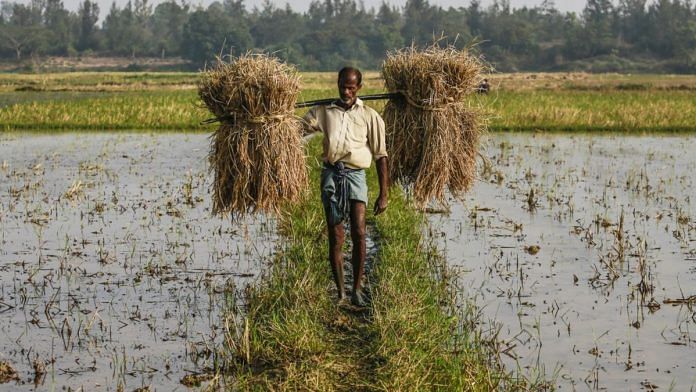New Delhi: The India Meteorological Department (IMD) has predicted a normal monsoon this year, spelling some cheer for the country’s agriculture sector amid the Covid-19 lockdown.
According to the first IMD forecast released Wednesday — to be updated next month — the southwest monsoon this year will be 100 per cent of the long period average (LPA).
LPA represents the average annual rainfall received by India during the southwest monsoon over the five decades from 1961 to 2010. Estimated at 88 cm, this figure serves as the standard against which the performance of the southwest monsoon is judged every year.
The monsoon forecast is critical to India’s food production and GDP growth — deficient rains could adversely impact farmer incomes and thereby drag down rural demand and consumption. This could hurt overall economic growth, especially at a time when agriculture is expected to be the only bright spot for India in 2020-21.
While manufacturing is expected to be hit partially because of Covid-19 and the lockdown, the services sector — aviation, travel and tourism — is not expected to recover at least in the first half of 2020-21
India is the world’s biggest producer of sugar, cotton and pulses, and the second-biggest producer of wheat and rice.
The success of these crops is largely determined by the June-September southwest monsoon, which delivers about 70 per cent of the country’s annual rainfall.
Also Read: Agriculture, construction and manufacturing units get relief under new norms for lockdown 2
‘Positive news for farmers’
Lasting from June to September, the southwest monsoon plays a vital role in irrigating more than half of India’s agricultural lands, which in turn helps sustain the livelihood of over 50 per cent of the country’s population. It plays a particularly important role in the cultivation of kharif crops like rice, maize, sorghum and cotton.
Monsoon rains have become even more crucial in recent years as consecutive dry monsoons have caused the country’s water crisis to worsen. Government thinktank NITI Aayog said in a 2018 report that 21 Indian cities — including New Delhi, Hyderabad and Chennai — could run out of groundwater by 2020.
“This (normal monsoon prediction) is positive news for farmers… as it will promote sowing and further cultivation of major Kharif crops like paddy in the coming times,” Siraj Hussain, former secretary, Union Ministry of Agriculture, told ThePrint.
Agriculture policy expert Devinder Sharma also expressed optimism about the monsoon forecast. “This may give a much-needed boost to Indian agriculture, which has witnessed a setback after the lockdown, as paddy is a water-intensive crop.”
However, Kumar was wary about completely relying on the monsoon forecast for predicting growth in agricultural output. “Much work needs to be done as, during the extended lockdown, the supply of agricultural inputs like fertiliser and pesticide remains critical,” he said.
Also Read: Punjab and Haryana stare at massive farm crisis as lockdown leads to labour shortage
‘Many welcome measures’
Indian agriculture and allied sectors have been hit hard by the complete nationwide shutdown effected to control the spread of Covid-19, which was preceded by years of rural distress driven by factors such as low income, debt and weather fluctuations.
The first set of guidelines issued after PM Narendra Modi announced the lockdown on 24 March didn’t make any exceptions for agriculture-related activities, but a subsequent order issued 27 March provided relief for several operations for farmers and farm workers, manufacturing an packaging units for fertilisers, pesticides and seeds, and movement of harvesting- and sowing-related equipment.
The relief stays in place for phase 2 of the lockdown, which began Tuesday and will continue until 3 May.
However, ThePrint’s travels through the rural hinterland in Uttar Pradesh amid the lockdown revealed a dismal picture. Many farmers complained of a shortage of diesel to run irrigation pumps as some petrol stations remained shut despite being exempt from the restrictions as an essential service. There were also several complaints about the unavailability of farm labour, besides fodder for cattle.
The sale of poultry products was hit by rumours they posed a Covid-19 threat, and farmers took time adjusting to disruptions in marketing and supply chains.
Asked about the measures taken by the central government to ensure the smooth functioning of agriculture and allied sectors amid the lockdown, Hussain said: “Much… depends on how states implement the decisions at their end… However, many welcome measures have been introduced by both state and central governments.”
Driven by increased cultivation in West Bengal, Telangana and Odisha, there has been an increase in sowing of summer crops, according to Ministry of Agriculture estimates.
Summer crops were sown on 48.76 lakh hectares in 2019-20 as compared to 37.12 lakh hectares in 2018-19. The growth is fuelled by an increase of 8.77 lakh hectares in the area of cultivation for rice.
Also Read: With 3% growth this year, India’s agriculture output will be a lone bright spot for economy







No doubt it is a silver lining, but not a silver bullet. Like many forecasts on GDPs going awry, the forcast should be taken with caution. There can be many a slips between the cup and lip. India is an agricultural country and should focus on its intrinsic strength rather than on MSME or export sector. Our thrust should be on, to pitch for 300 million tonnes of food production, make proper arrangements to stock the grains avoid spoilage in storage and get better returns for agriculturist. This will kick start the rural economy and other sectors like secondary and tertiary sector will follow suit. Concentrate our core strength i.e., domestic demand rather than export markets which are more dicey than ever.
I am yet to hear any other forecast from Met Department other than , “Normal Monsoon”. In reality “Normal Monsoons ” are rare.